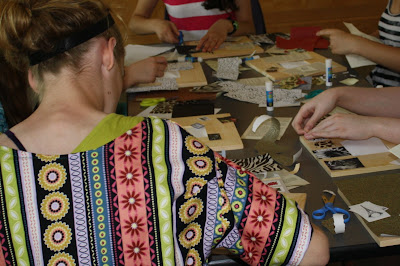Teens will always keep you guessing... I knew this mirror project was going to be a hit with my DIY Friday library group. What I didn't realize is how much teens love collage and working with Modge Podge. It was the best project yet, everyone was relaxed, creatively engaged and in the end tremendously proud of their mirrors.
I collected an assortment of black, white, ivory and red scrapbook papers from my stash. Our wonderful young adult librarian supplied photocopied iconic images from France along with an old french novel for tearing apart. I also borrowed a set of themed stamps from a crafty friend.
Start by covering the center of the mirror with a scrap of paper to prevent it from getting gunked up with glue. The teens launched straight into selecting papers and arranging them over the four sides of the frame.
Once they were sure of the placement they used gluesticks to anchor the paper pieces in place.
Hands at work stamping images to collage onto their frame.
I brought my paper cutter along and it was passed between tables. It's the fastest and easiest way to cut a perfect straight edge.
I encouraged all the teens to just cover the top surface of the frame. Bending the paper around edges can be problematic, causing bumps and uneven edges. I love the tissue tearing technique that this artist used, it gives texture to the sides of the piece.
Despite the fact that everyone was sharing the same materials and wooden frames there was terrific diversity in the way they approached the project and their finished frames.
It was fascinating to watch this frame come together, beautiful balance and design.
The final step was to apply a coat of Modge Podge over the surface. In a few cases we had trouble with the paper wrinkling. When that happened we simply lifted up the offending piece and applied a layer of Modge Podge under it and then repositioned it, instant fix.









































